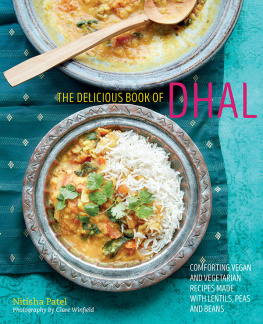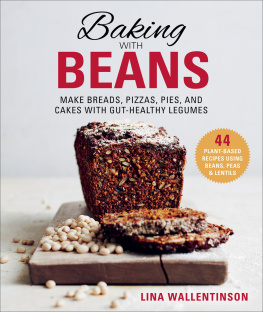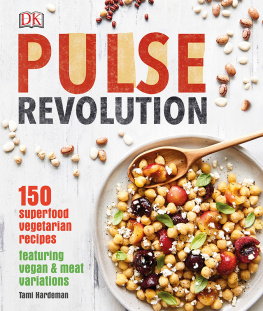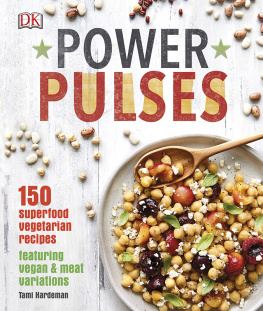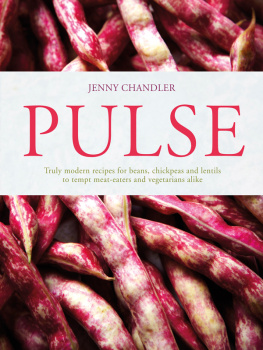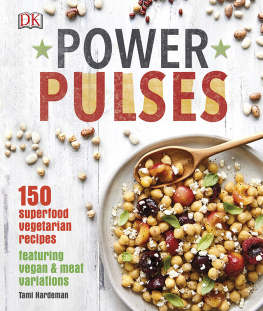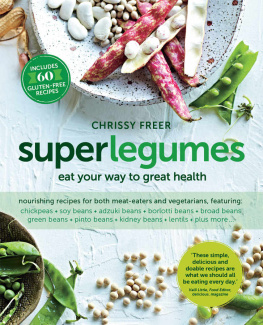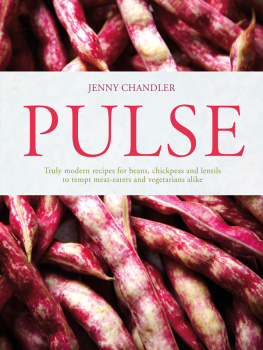Clockwise from top left: Desi Chickpea, Black Kabuli Chickpea, Chestnut Chickpea, Winnifreds Garbanzo, Edible Island Chickpea, Chickpea of Spello.
Chapter 7
Chickpeas
Chickpeas (Cicer arietinum) are also known as garbanzos or garbanzo beans. Quite an unknown fact in North America is that chickpeas are as delicious as shelling peas when eaten fresh. In Ethiopia, I often saw children selling branches of chickpeas by the roadsides before the plants had started to dry down; they are considered a special treat to pop right into the mouth.
As with lentils, Canada exports a huge amount of chickpeas all over the world. Most production is in Saskatchewan and southeastern Alberta. Sadly (I think), Canada also imports a lot of chickpeas. You cant find Canadian-grown garbanzos in most grocery or health food stores in Canada, but you can find chickpeas from Mexico, India and other far-off farms. And, although they are grown on more than two hundred thousand acres in the US, primarily in California, Idaho, Montana and Washington, few Americans eat their own chickpeas.
Falcon Faces
Chickpeas have been grown in Mediterranean countries for ten thousand years. They were known by the name falcon face in ancient Egypt. The Romans used the word arietinum (ram-like) to describe this roundish, compressed seed that somewhat resembles a rams head with horns curling over the sides. Cicer arietinum was a staple of their diet and still plays a very important part in the regional cooking of southern Europe. Chickpeas are widely grown in India and Burma, where they rival wheat in acreage under cultivation.
In North America, shelled fresh chickpeas are a yet-to-be-discovered treat. Photos Jan Mangan
Growing Chickpeas, Placing Plants
The chickpea is a graceful and delicate-looking plant that branches near the ground and is usually about 2 feet (60 cm) high. About 4 months from the time of sowing, 1 to 2 seeds are borne in each of the numerous round swollen pods. It is quite a substantial plant that spreads more than 1 foot (30 cm) in all directions.
Like peas, favas and lentils, chickpeas are a cool-weather crop. Seeds can be sown once the temperature stays over 40F (4C), which in most places means they are best planted in late March to mid-April. They can tolerate frost in the cold season and even withstand high summer temperatures during flowering.
The plants are best grown in rows 18 inches (46 cm) apart and thinned to about 1 foot (30 cm) apart because of their spreading habit. They require little attention beyond the occasional weeding or hoeing and are quite drought-tolerant. I normally mulch my rows of chickpeas once they are 2 to 3 inches (5 to 7.5 cm) high; then I dont have to do anything for them until harvest. They dont need staking, and in fact are so robust that Ill often plant a row of bush peas just a foot (30 cm) away so that the tendrils of the peas can cling to the chickpeas to stay upright.
The Shelling Shuffle
The dry pods of chickpeas are more difficult to process than those of other beans because the shells have a lanolin-like stickiness and cave in rather than split apart when hand-threshed. So placing them on a tarp or in a large box or rubber bin and doing the shuffle on them is the way to go. For more information, see .
As with other pulses, they should be stored in a cool, dry and dark place.
Most people, seeing chickpeas growing for the first time, remark on their grace and beauty. Karen Mouat photo
Chestnut Chickpeas, Winnifreds Garbanzo
Ive been experimenting with chickpeas for quite a number of years. One of the varieties Ive maintained is the large-seeded Chestnut, the only cream-coloured cultivar commonly available in North America. I also have a similarly sized black garbanzo that hails from Afghanistan and is called Kabuli. My friend Rupert Adams brought back a standard Indian chickpea gifted to him by Vandana Shiva at her Navdanya Institute in India. This chickpea, called Desi, is a smaller, dark-brown seed and has become one of my favourites due to its flavour, production and reliability.
Another favourite for similar reasons is Winnifreds Garbanzo. Winnifred had already been growing it for 30 years before she shared some seeds with me 20 years ago. Although I did not have the chance to meet her in person before she died, we spoke on the phone dozens of times and I was always inspired by how self-sufficient she was, living totally off the grid in a very remote area of BC.
As with dry peas, favas and lentils, youll be hard-pressed to find chickpeas offered in any garden seed catalogues. Ive been doing my best to change that!
Left: At harvest time, garbanzos rattle in their pods ( Karen Mouat photo ). Right: The flowers of Black Kabuli Chickpeas are a pretty pink and white ( Photo Jan Mangan ).
Chickpea Chapati, Condiments and Curry
Around the world, chickpeas are used in a wide variety of snacks, soups, sweets, curries and condiments, and are well known for their tastiness in such foods as dhal and tabbouleh. They are also ground to produce a fine flour called besan to make roti or chapati; this flour is wonderful for those who are gluten intolerant, and useful for making virtually all types of breads, for baking and even for pancakes. In the Middle East, chickpeas have long been widely consumed as hummus. See for a new twist on traditional hummus recipes.
If youre used to preparing dishes with dry or canned chickpeas, youll be surprised and delighted at the difference when you use homegrown ones. As with other garden-fresh beans, their taste is mild and sweet and cooking times are considerably less than is usually recommended. For fresh chickpeas, 1 hours of simmering (rather than the standard 2 hours) after an overnight soak will be sufficient.
Chickpea pods have a lanolin-like coating that keeps dew and rain out. Karen Mouat photo
From left to right. Top row: Teggia Bush Dry Bean, Beka Brown, Black Turtle, Borlotti Bean; second row: Ireland Creek Annie, Hutterite Soup Bean, Calypso, Pinks Bush Dry Bean; third row: Candy, Aztec Red Kidney, Tiger Eye, Orca; bottom row: Ruckle, Black Coco.
Chapter 8
Beans
By beans, I am referring to what the Food and Agricultural Organization of the United Nations calls the common bean or Phaseolus vulgaris. These include pinto, kidney, navy and chili beans, plus a host of other soup, baking, salad and refry beans.
Bean Travelling
Unlike the other pulses described so far, these beans are warm-weather crops and their origins are in Central and South America. Columbus found these beans growing in America, and their cultivation had been going on for thousands of years before then. He brought them to Europe and, during the 16th and 17th centuries, they became more popular than other beans such as favas, and then early settlers brought them to North America.


